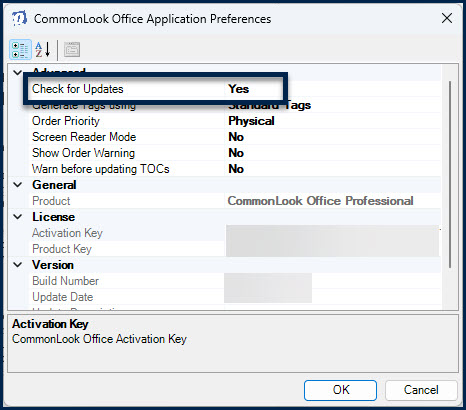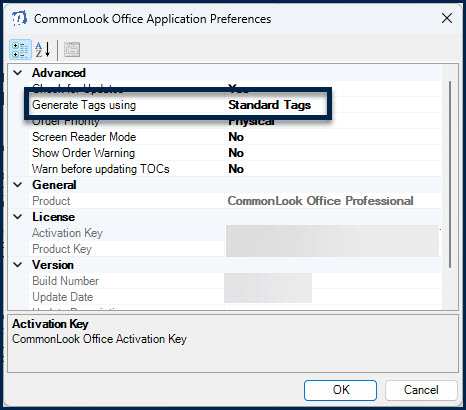On this page: Introduction | How Does it Work | Using CommonLook Office | Comments and Track Changes | Standards Conformance | Quick Start Guides | Training
Introduction
CommonLook Office is an add-in to Microsoft Word and PowerPoint that enables the creation of accessible PDFs without prior knowledge of accessibility. With CommonLook Office, you can immediately begin making high-quality accessible PDFs that conform to a wide variety of accessibility standards.
How Does it Work?
When CommonLook Office is launched, and you choose your accessibility standard, the wizard then tests the document against that standard. Any issues, or potential issues, are brought to your attention so they can be addressed prior to PDF generation. After all issues, or potential issues, have been addressed, a tagged, accessible, standard-compliant PDF is created.
In addition, a report may be generated to certify that the PDF has passed all the checkpoints relevant to the selected accessibility standard.
Using CommonLook Office
- Open a Word document or PowerPoint.
- Choose CommonLook Office in the ribbon.

- Select Create CommonLook PDF.

- Choose the standard you want your PDF to comply with, when it’s created. (Choose “Cancel” if you need to continue creating/ editing your document.)
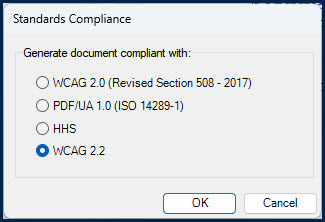
- After it’s done opening, the CommonLook Office panel will appear on the right of the screen, open on the “Current Checkpoint” tab.
- Follow the instructions in the yellow box, above the “Current Checkpoint” tab. If more information is needed for a particular checkpoint, follow the “More” link in the yellow box at the top of the panel.

- If corrections need to be made to the document, either close CommonLook Office to make the changes or simply make the changes in Word or PowerPoint. When making changes to the document (or PowerPoint) with CommonLook Office open, be sure to use the “Reload” button.
Note: If you need to make changes to the document and the checkpoint you’re on, in CommonLook Office, doesn’t have a “Reload” button then you’ll need to close CommonLook Office, make the change in Word or PowerPoint, and then relaunch CommonLook Office.
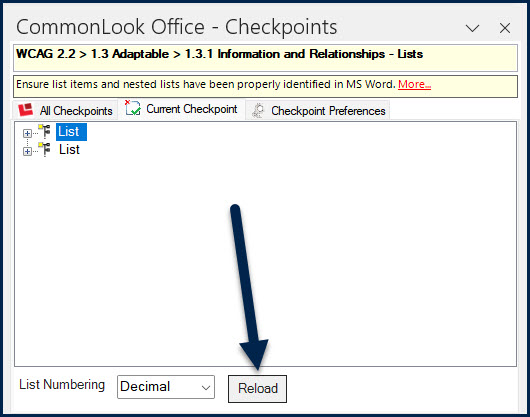
- As errors are fixed, choose Next Task to move to the next item.
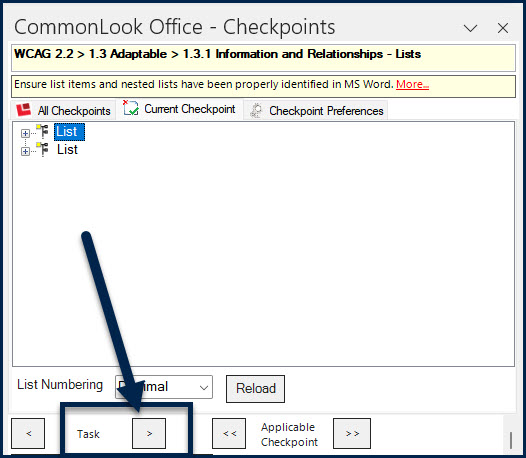
- Once all tasks for the current checkpoint have been completed, the first task in the next applicable checkpoint is displayed.
- After all applicable checkpoints have been addressed, CommonLook Office generates an accessible PDF. As previously mentioned, there is also the option to generate a report to certify that the PDF document meets the chosen accessibility standard.
Manually Running Checkpoint(s)
To manually run a checkpoint (once) in CommonLook Office, follow these steps:
- Open the “All Checkpoints” tab,
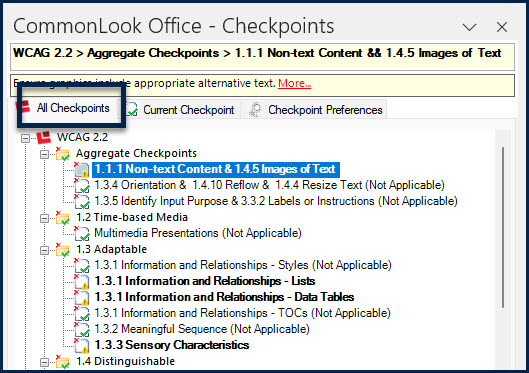
- Choose the checkpoint from the list,
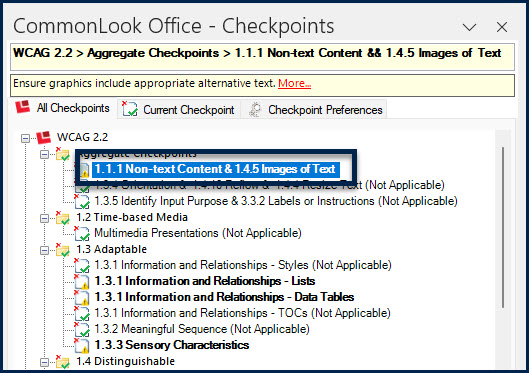
- Navigate to the “Current Checkpoint” tab,
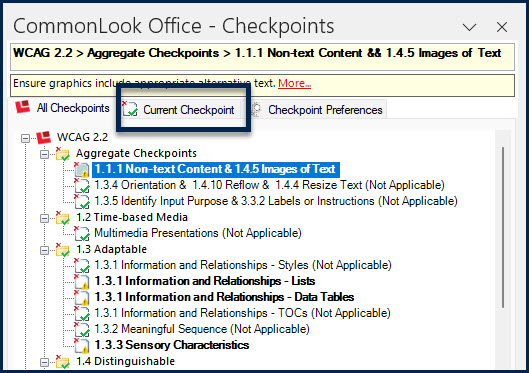
- Follow the instructions provided.
To set the software to run a checkpoint every time a document is tested, follow these steps:
- Open the “All Checkpoints” tab,

- Choose the checkpoint from the list,

- Navigate to the “Checkpoint Preferences” tab,
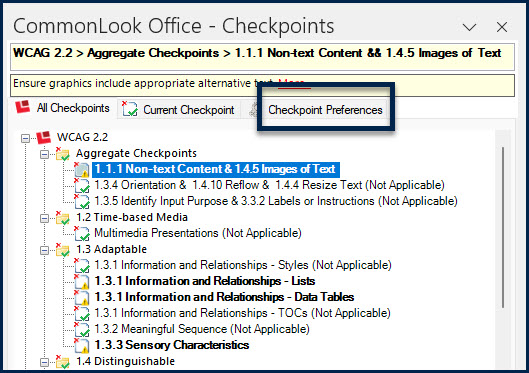
- Select the “Checkpoint Navigation Mode,”
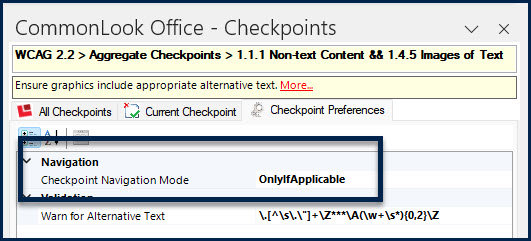
- Use the dropdown menu to set the mode to “AlwaysStop.”
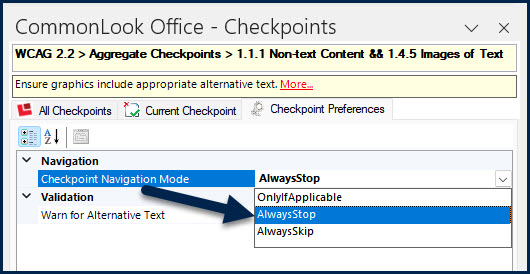
Alternative Workflows
CommonLook Office is designed to guide you, step by step, through a complete range of accessibility checks prior to saving a document or presentation to a PDF.
You may, however, also choose to address the checkpoints in any order or at any time. Simply choose the checkpoint from the “All Checkpoints” tab and then go back to the “Current Checkpoint” tab to address the concerns with that chosen checkpoint.
Certain advanced options for the application settings are available by choosing the CommonLook Office Preferences button on the ribbon. From there you can:
Check for Updates: Checks the CommonLook Update Server for newer releases. Once a new release has been detected, it offers to download and install the newer release. The default is set to “Yes.” Read more below about automatic updates for CommonLook Office.
With the release of CommonLook Office version 2.0.9, for users on an annual subscription, or a trial, CommonLook Office will automatically check for updates if the “Check for Updates” option is set to “Yes” (the default setting). When there’s an update available, it’ll inform you and ask if you want to download and install it. (If you’re running the software on the “Single User” licensing model then you’ll be told that there are updates, but they won’t be automatically downloaded. Please contact support@allyant.com for the download.)
Set “Check for Updates” to “No” if you don’t want CommonLook Office to automatically look for updates. Tip: If you set “Check for Updates” to “No,” use the “Check for Updates” button on the ribbon to manually find out if there are updates available.
If you use the “Check for Updates” button on the ribbon and learn that there’s an update available, CommonLook Office will ask you if you want to download and install it.
Generate Tags using: This menu gives you the option to create tags using Standard PDF tag names (H1, for example) or to use the Style names, from Word and PowerPoint as the tag names (Heading 1, for example). If you choose to use the Office Style Names for your tags, those tags will be role mapped to standard PDF tags. So, for example, “Heading 1” will be role mapped to “H1.”
Note: Our recommendation is to use Standard Tag names.
Order Priority: Choose to give priority to the document reflowing correctly (Reflow) in Adobe Reader’s Reflow mode, or (in some cases) the document displaying correctly (Physical).
Screen Reader Mode: If using CommonLook Office with a screen reader, change this setting to Yes in order to disable the selection of document elements while running CommonLook Office and improve the user experience. If you are not using a screen reader, this setting should be No.
Show Order Warning: When set to Yes CommonLook Office displays a warning when it reorders content (refer to the Order Priority setting, above) to ensure correct behavior in Adobe Acrobat’s Reflow mode. If you get this warning, please examine the pages indicated in the output PDF file for either reflow or visible errors, as indicated.
In addition, the checkpoints themselves have options to always run, always skip, or to only be run when applicable. For each checkpoint, adjust these settings in the “Checkpoint Preferences” tab.
Comments and Track Changes
CommonLook Office will not process Word or PowerPoint files that contain review markup (Track Changes) or comments. If your documents contain those things, you’ll get an error message and CommonLook Office will close. Turn off Track Changes, remove comments, etc., and then open CommonLook Office to make the accessible PDF.
Standards Conformance
As previously mentioned, when opening CommonLook Office, you’re asked to choose a standard to which the PDF should conform. When used properly, CommonLook Office will generate PDFs that conform to WCAG 2.0AA (the “Refreshed” Section 508 as of 2017), PDF/UA, the U.S. Dept. of Health and Human Services (HHS) standard, and/or WCAG 2.2AA.
Use the Quick Start Guides
We’ve created Quick Start Guides for both Word and PowerPoint to get you up and running quickly, using CommonLook Office. For each, you can download a sample Word document or PowerPoint presentation and follow the instructions on how to run them through CommonLook Office.
Copy the URLs below, as needed, and paste them into your browser, to navigate to the Quick Start Guides.
- Quick Start in Word: https://allyant.freshdesk.com/solutions/articles/156000018398
- Quick Start in PowerPoint: https://allyant.freshdesk.com/solutions/articles/15600001838
Training
Allyant provides a variety of training options for help with using our software. Please check out the classes on the Allyant website training calendar (https://allyant.com/events/category/events-training/) or contact your Account Executive for more information.
